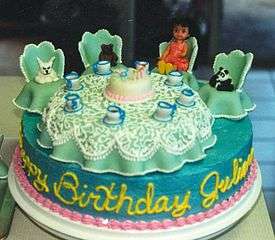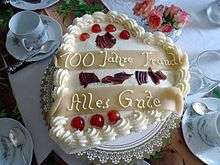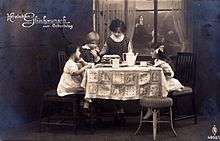Birthday cake
|
A chocolate buttercream birthday cake | |
| Type | Cake |
|---|---|
|
| |
A birthday cake is a cake eaten as part of a birthday celebration in many world traditions. Variations of the typical birthday cake include birthday cupcakes, cake pops, pastries, and tarts. While there is not a universal standard regarding taste, birthday cakes are often vanilla-, chocolate-, or strawberry-flavored. They are also baked in a variety of shapes and decorated in one color or multiple colors with icing or fondant.
History
Birthday cakes have been a part of birthday celebrations in Western European countries since the middle of the 19th century.[1] However, the link between cakes and birthday celebrations may date back to ancient Roman times.
In classical Roman culture, 'cakes' were occasionally served at special birthdays and at weddings. These were flat circles made from flour and nuts, leavened with yeast, and sweetened with honey.
In the 15th century, bakeries in Germany began to market one-layer cakes for customers' birthdays as opposed to only marketing cakes for weddings, and thus the modern birthday cake was born. During the 17th century, the birthday cake took on its contemporary form. These elaborate 17th century cakes had many aspects of the contemporary birthday cake, like multiple layers, icing, and decorations. However, these cakes were only available to the very wealthy. Birthday cakes became accessible to the lower class as a result of the industrial revolution and the spread of more materials and goods.
Contemporary rites

The cake, pastry, or dessert is served to a person on their birthday. In contemporary Western cultures, the one individual being celebrated will blow out a number of candles on the cake.

There is no standard for birthday cakes, though the "Happy Birthday" song is often sung while the cake is served in English-speaking countries, or an equivalent birthday song in the appropriate language of the country. The phrase "Happy Birthday" did not appear on birthday cakes until the song "Happy Birthday to You" was popularized in the early 1900s. Variations of birthday songs and rituals exist in different parts of the world. In Uruguay, party guests touch the person's shoulder or head following the singing of "Happy Birthday to You". In Ecuador, the person whose birthday it is will take a large bite of the birthday cake before it is served.

The birthday cake is often decorated with small candles, secured with special holders or simply pressed down into the cake. The cake can also be served with other sweets such as ice cream. In the UK, North America and Australia, the number of candles is equal to the age of the individual whose birthday it is, sometimes with one extra for luck. Traditionally, the person whose birthday it is makes a wish, which is thought to come true if all the candles are extinguished in a single breath.
To represent a sharing of joy and a sense of togetherness, the cake is shared amongst all the guests attending the party.
Candles and theories of origin

Though the exact origin and significance of the candle blowing ritual is unknown, there are multiple theories which try to explain this tradition.
Greek origin story
One theory explaining the tradition of placing candles on birthday cakes is attributed to the early Greeks, who used candles to honor the goddess Artemis' birth on the sixth day of every lunar month. The link between her oversight of fertility and the birthday tradition of candles on cakes, however, has not been established.
Pagan origin story
.jpg)
The use of fire in certain rites dates back to the creation of altars. Birthday candles hold symbolic power.[2]
In the past it was believed that evil spirits visited people on their birthdays and that, to protect the person whose birthday it was from evil, people must surround the individual and make them merry. Party-goers made noise to scare away evil spirits.
German origin story


In 18th century Germany, the history of candles on cakes can be traced back to Kinderfest, a birthday celebration for children.[3] This tradition also makes use of candles and cakes. German children were taken to an auditorium-like space. There, they were free to celebrate another year in a place where Germans believed that adults protected children from the evil spirits attempting to steal their souls. In those times there was no tradition of bringing gifts to a birthday; guests would merely bring good wishes for the birthday person. However, if a guest did bring gifts it was considered to be a good sign for the person whose birthday it was. Later, flowers became quite popular as a birthday gift.[4]
- In 1746, a large birthday festival was held for Count Ludwig von Zinzendorf at Marienborn near Büdingen. Andrew Frey described the party in detail and mentions, "there was a Cake as large as any Oven could be found to bake it, and Holes made in the Cake according to the Years of the Person’s Age, every one having a Candle stuck into it, and one in the Middle."[5]-Gotha-Altenburg]], recounts of his 52nd birthday on 28 August: "... when it was time for dessert, the prince's entire livery in full regalia entered, led by the majordomo. He carried a generous-size torte with colorful flaming candles - amounting to some fifty candles - that began to melt and threatened to burn down, instead of there being enough room for candles indicating upcoming years, as is the case with children's festivities of this kind."[6] As the excerpt indicates, the tradition at the time was to place one candle on the cake for each year of the individual's life, so that the number of candles on top of the cake would represent the age which someone had reached; sometimes a birthday cake would have some candles 'indicating upcoming years.'
Swiss origin story
A reference to the tradition of blowing out the candles was documented in Switzerland in 1881. Researchers for the Folk-Lore Journal recorded various "superstitions" among the Swiss middle class. One statement depicted a birthday cake as having lighted candles which correspond to each year of life. These candles were required to be blown out, individually, by the person who is being celebrated.[7]
Birthday cakes in different cultures

There are many variations of sweets which are eaten around the world on birthdays. The Chinese birthday pastry is the shòu bāo (壽包, simp. 寿包) or shòu táo bāo (壽桃包, simp. 寿桃包), a lotus-paste-filled bun made of wheat flour and shaped and colored to resemble a peach. Rather than serving one large pastry, each guest is served their own small shou bao. In Korea, the traditional birthday dish is seaweed soup. In Western Russia, birthday children are served fruit pies with a birthday greeting carved into the crusts. The Swedish birthday cake is made like a pound cake that is often topped with marzipan and decorated with the national flag. Dutch birthday pastries are fruit tarts topped with whipped cream. In India there are very few people use birth celebration in villages but cities and towns birthday cakes are used similarly to western people specilly among higher educated section.
See also
References
- ↑ "Birthday Cakes: History & Recipes - Online article with an extensive bibliography".
- ↑ (The Lore of Birthdays (New York, 1952), Ralph and Adelin Linton, pp. 8, 18-20.)
- ↑ "Keeping the Legacy". German Hausbarn.
- ↑ "History of Birthdays".
- ↑ Frey, Andreas (1753-01-01). A true and authentic account of Andrew Frey. Containing the occasion of his coming among the ... Moravians [&c.]. Transl.
- ↑ Shirley Cherkasky: Birthday Cakes and Candles, p. 220 books.google. "Meinen eintretenden Geburtstag wollte man mit gnädiger Aufmerksamkeit bei einem solchen geschlossenen Mahle feiern; schon an den gewöhnlichen Gängen sah man einigen Unterschied; beim Nachtisch aber trat nun die sämtliche Livree des Prinzen in stattlich gekleidetem Zug herein, voran der Haushofmeister; dieser trug eine große, von bunten Wachsstöcken flammende Torte, deren ins Halbhundert sich belaufende Anzahl einander zu schmelzen und zu verzehren drohte, anstatt daß bei Kinderfeierlichkeiten der Art noch Raum genug für nächstfolgende Lebenskerzen übrigbleibt." Goethe's Tag- und Jahreshefte 1801 http://www.zeno.org/nid/20004859979
- ↑ The Folk-lore Journal. Folk-lore Society. 1883-01-01.
| Wikimedia Commons has media related to Birthday cakes. |
